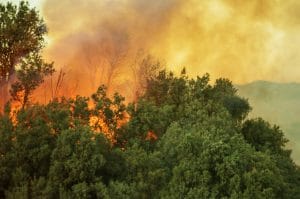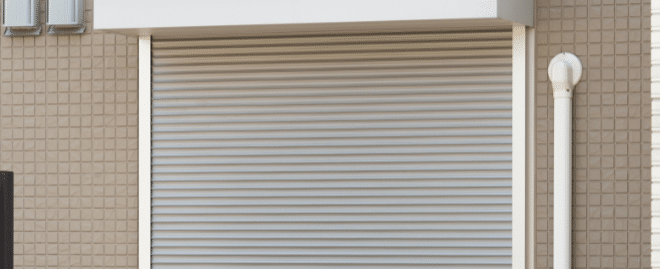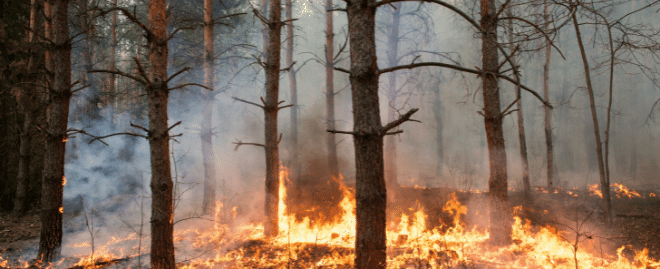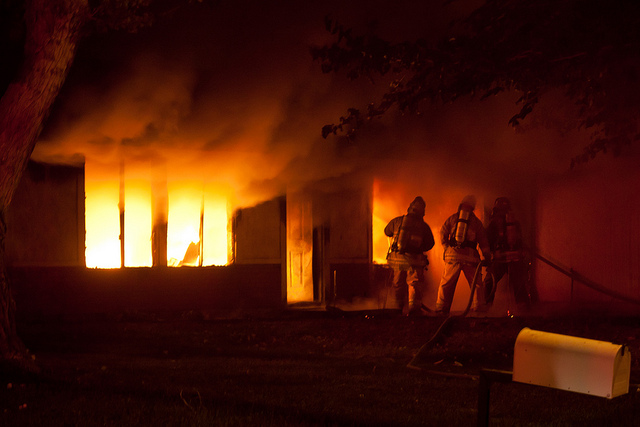Complete Guide for Wildfire Preparedness
Forestry and mountains make for beautiful scenery, giving those who live near such a setting great views from the comfort of their homes. However, these areas are also prone to hazards like wildfires, putting nearby residents in danger. Wildfires usually begin unnoticed, being triggered by accidents or by lightning. But once a wildfire is lit, it spreads quickly. Soon enough, nearby trees and other vegetation catch fire, too, and will eventually reach residential areas.
When major wildfires reach residential areas, a lot of homes don’t survive. But there are homes that do, and the likely cause for surviving a major wildfire comes from the preparation conducted for it.
Knowing this, it is important that you do what’s necessary to limit the potential for damage by a wildfire. And while you cannot necessarily stop an emergency from happening, you can prepare yourself for one so that you know what to do if one arises.

Forest fires can move fast and are extremely dangerous. Have an emergency preparation plan in place to be ready.
Create Emergency Plans
An important step in preparing for wildfires is to create an emergency plan for your family.
Identify an out-of-state friend or relative who will act as a contact, and let them know he/she has been chosen as such. In the event of a wildfire, tell them you’re safe. It’s crucial that your contact is from out-of-state; he/she is more likely to be reached, because the individual probably won’t be affected by the wildfire. Have your emergency contact’s information stored in everyone’s cell phone as the emergency contact.
If phone service isn’t reliable at the time of the emergency, text messages are a good option. Oftentimes, texts can get through when phone service isn’t working well.
In addition to an emergency contact, you need to establish meeting places. You need to identify a couple different options for meeting places in case the locations are also in the area affected by the wildfire.
At home, develop escape routes, map them out, review them, and make sure everyone knows and can follow them.
Create an Emergency Kit
If an emergency comes up, chances are you won’t have enough time to gather all the necessities that you and your family need. That said, you should prepare an emergency kit ahead of time. That way, if there is an emergency, you’ll already be prepared and can act quickly.
For your kit, you should include enough supplies to last you and your family three days. Be sure to include necessities for each individual, such as certain medications. The following are among some of the items you should include in your emergency kit:
- Copies of important documents: driver’s licenses, identification cards, birth certificates, health insurance cards, and more
- A first-aid kit
- One gallon of water per person for each day
- Non-perishable food
- Personal sanitation items: garbage bags, toilet paper, moist towelettes, and more
- A flashlight
- A battery-powered radio
- Spare batteries for electronics
- Spare chargers or portable batteries for electronic devices
- A whistle

Create an Emergency Kit
If you’re in an area with cold weather or will head to a place with cold weather, make sure you have cold weather essentials: warm clothing, jackets, blankets, and more.
If you have any pets, make an emergency kit for them as well, including their essentials like food and medications.
Check Your Insurance Coverage
Check your homeowner’s insurance policy to see what is covered within your plan. If your plan doesn’t cover fire or smoke restoration services, then you should consider adding more coverage. That way, if your home is a victim of a wildfire, your insurance will cover repairs and restoration needed to address the damage.
Fireproof Your Home
For the building materials of your home, such as siding and roofing, use materials that are fire-resistant or noncombustible. If your home doesn’t have such materials already, consider replacing them with ones that are resistant to fires. You can also decide to treat these building materials with fire-retardant chemicals.
For your home’s landscaping, include plants that are fire-resistant and will contain fires instead of adding ones that fuel fires and are more prone to flames. For example, hardwood trees are not as flammable as evergreen trees. By doing this, your landscaping can act as an extra layer of protection against fires for your home.

Fireproof Your Home
Limit Potential for Fires
The recommendation is to create a 30- to 100-foot safety zone that surrounds your home. So this area should have minimal sources for fires.
Remove easily flammable items from the safety zone like flammable vegetation. Rake up leaves and twigs, remove dead trees, and dispose of them appropriately. You should clean your home’s gutters on a regular basis, because the leaves and other debris that gather in there can easily catch fire from embers. Additionally, mow your lawn on a regular basis.
Inside your home, have professionals perform semiannual chimney inspections and yearly cleanings to limit potential for any malfunctioning. Make sure there are smoke detectors on every level of your home, but you especially need to have ones installed by bedrooms. Conduct monthly tests, and change the batteries on an annual basis.
You can also add fire-resistant drapes and install protective shutters to your home.
What to do if a Wildfire is Near

Wildfire
If it has been recommended that you do an emergency evacuation, then you should evacuate your home immediately. When doing so, be sure to bring your disaster kit and travel away from the fire. If you spot a wildfire and suspect it hasn’t been reported because you haven’t been instructed to evacuate, then call 911.
If you have time to prepare before evacuating, make sure you and your family are dressed appropriately; wear cotton clothing, long-sleeved shirts, pants, sturdy shoes, gloves, and a handkerchief for your face. Close all doors, windows, and other openings to your home, and remove flammable curtains and drapes. Furthermore, turn your gas and fuel sources off.
Outside of your home, grab your garden hose and fill any pools, garbage cans, and other large containers outside with water. Place lawn sprinklers on the roof and leave them on to moisten the roof. This will make the roof more resistant to the fire.
Finding out that you are in an area threatened by wildfires can be an overwhelming and stressful experience. But by taking these steps, you can safeguard your home against a wildfire, and you can ready yourself and your family for such an emergency.
If you return to your home only to find it has suffered damage from a wildfire, be sure to seek professional fire damage restoration services immediately. The longer you wait, the worse the damage becomes. Professionals will not only tend to building materials that have been damaged by the fire’s flames, but they will also address smoke and soot damage, thoroughly restoring your property to a safe living space yet again.












